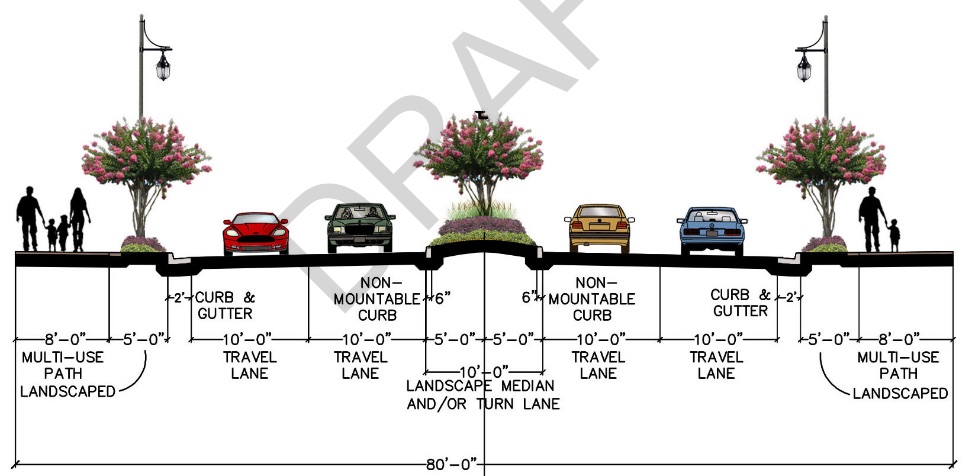by Jeremy Morrison, Inweekly–
The architectural renderings are pretty, but at this point they are only the fever-dream visions of cycling enthusiasts and Complete-Street wonks.
“This is obviously nothing official,†clarified David Mayo, chairman of the Pensacola Bicycle Advisory Committee, as he showed off the renderings during the committee’s Nov. 30 meeting.
The images depicted a North Palafox featuring two lanes for vehicles separated by tree-lined ‘bioswales’ from six-foot bike lanes and sidewalks on either side of the road. Likewise, Cervantes is shown with minimized traffic lanes complemented by landscaping, bike lanes and sidewalks. Similarly along Summit Boulevard.
The renderings offered a glimpse of what could be done in the Pensacola area to slow cruising traffic and create a safer environment for bicyclist and pedestrians. They illustrate what is known as a road-diet, and allow for designated biking and walking spaces.
“It’s just good to be able to visualize something,†Mayo said.
Currently, reality is a far cry from the BAC’s road renderings. On the street, bicyclist and pedestrians on roadways like Palafox, Cervantes and Summit travel right alongside whizzing traffic enjoying luxuriously wide lanes that encourage higher speeds. The committee would like to see more biker and walker-friendly designs — designs falling under the Complete Streets philosophy of connectivity — incorporated locally.
[pullquote]“We’re trying to attract millennials, we’re trying to attract the creative class.†-Rand Hicks[/pullquote]
“We’re trying to attract millennials, we’re trying to attract the creative class,†said BAC member Rand Hicks. “They don’t necessarily want to own cars, they want to ride bikes.â€
This summer, Pensacola’s bicycle committee submitted a number of proposed roadway projects to the Florida-Alabama Transportation Planning Organization for potential funding. But there are no illusions about the chances of actually securing any money for the projects.
“If anything is going to really truly be done, it’s going to have to come through the city,†Mayo conceded.
The 11 projects submitted to the FL-AL TPO by the local bicycle committee, in order of priority, are: 14th Avenue roadway rebalance with sharrows (markings, or arrows, in a lane indicating it is shared with bicyclists); Palafox Street, from Fairfield to Main, restriping and a road diet to create two travel lanes and protected bike lanes; Summit Boulevard, 12th Avenue to Scenic Highway, restriping to establish bike lanes; Government Street, from Barrancas to 9th Avenue, roadway rebalance to include bike lanes; Spring Street, from Gregory to Main streets, restriping to create bike lanes; Blount St., 20th Avenue to A Street, restriping and some sharrows; Bayou Boulevard, 12th Avenue to Cervantes, restriping and adding protected bike lanes; MLK Drive, from Texar Avenue to Garden Street, downsize to one car lane and add bike lane; Hayne Street, from Guillemard to Cross streets, road diet to allow for buffered bike lane; Cervantes Street Bayou Texar Bridge, align with East Cervantes Corridor Management Plan.
Mayo said that while some of the BAC’s proposals required substantial investment and work, others were of the low-hanging fruit variety.
“A lot of these things are simple,†he said. “They’re not taking out curbs and drainage. A lot of this is painting.â€
Pensacola City Councilwoman Sherri Myers was in attendance at the BAC’s November meeting, and told the committee that the TPO submittals didn’t reflect her personal preferences.
[pullquote]“My priority is 9th Avenue, and it’s not in here.†– Council member Sherri Myers[/pullquote]
“None of these road diets here are a priority of mine,†she said. “My priority is 9th Avenue, and it’s not in here.â€
Committee members agreed that there were other routs in the city that need attention, but said their list represented a prioritized sampling. Myers conceded that 9th Avenue was a heavy lift, but maintained it needed to be addressed.
Myers also said that the city’s bicycle advisory committee had become too small, with only a handful of members — four on Nov. 30 — regularly attending meetings. She suggested that its ranks of “cycling enthusiasts†be complimented with bicyclists who view bikes as their primary get-around.
“They are not bicycle enthusiasts,†Myers said, describing riders in her district, “They are riding bicycles because it’s their only transportation.â€
Myers told the BAC she was currently working on drafting a Complete Streets ordinance to introduce to city council soon. The ordinance, formalizing the city’s efforts towards walkability and pedestrian-friendly streets, will be helpful the next time the BAC applies for the League of American Bicyclists’ Bicycle Friendly Community designation.
The BAC’s recent attempt to secure that designation was unsuccessful. But it clearly wasn’t just the lack of a Complete Streets ordinance that doomed the application.
In rejecting Pensacola’s bid for the Bicycle Friendly Community’s Bronze designation, the League offered some suggestions for future bids. In addition to adopting a Complete Streets policy, the organization noted that the city should adopt standards laid out in the National Association of City Transportation Officials Design Guide, hire a bicycle and pedestrian coordinator and create a Bicycle Master Plan.
The organization also provided some insightful metrics, comparing Pensacola with the “average Bronze†city. While there were some bright spots, such as Pensacola having an active bike-advocacy group and bike-friendly laws, there were obvious trouble spots. For one, the city scored a 3 out of 10 for roadway connectivity, and a 4 when it came to motorists’ skills and bicyclists’ awareness. The city also scored poorly in categories gauging the enforcement of cyclists’ rights, the acceptance of cycling into the culture and also in city planning efforts geared toward accommodating cyclists. In a particularly grim comparison, the group looked at the number of cycling fatalities per 10,000 riders: Pensacola had 116, compared with an average of 21.
The Complete Streets aspect of this equation may be addressed early next year. Myers said she hoped to have an ordinance drafted for council to look at in January.
